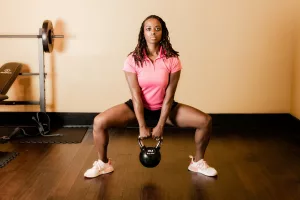Exercise myths can derail your fitness journey, causing confusion and potentially leading to ineffective or even harmful workouts. Let’s dive deeper into some common misconceptions and provide actionable tips to help you navigate your fitness path more effectively. Myth #1: Cardio is the Only Way to Lose Weight While cardio workouts are fantastic for burning calories and improving cardiovascular health, they aren’t the sole solution for weight loss. Strength training plays a pivotal role in weight management. By building muscle, you increase your resting metabolic rate, which means you burn more calories even at rest. For example, incorporating exercises like squats, deadlifts, and bench presses can significantly enhance muscle mass and metabolic rate. A balanced weekly routine might involve three days of cardio and two days of strength training, allowing your body to benefit from both aerobic and anaerobic activities.
Expanding Your Cardio Approach
Consider varying your cardio routine to avoid plateaus and maintain interest. This could include activities like cycling, swimming, or even dance classes. Interval training, which alternates between high and low intensity, can maximize calorie burn and improve cardiovascular fitness in a shorter time frame. For instance, try a 20-minute session alternating between one-minute sprints and two-minute recovery periods.
Myth #2: Crunches Are the Best Way to Get Abs
Spot reduction is a persistent myth, but achieving visible abs requires more than just crunches. A core workout should engage various muscle groups. Include exercises like planks, which target your entire core, and leg raises, which emphasize the lower abdominal muscles. Russian twists can improve oblique strength, contributing to a toned appearance. Remember, a healthy diet and overall fat loss are crucial for revealing those abs. Aim for a diet rich in lean proteins, whole grains, and plenty of vegetables to support your workout efforts.
Integrating Core Workouts
Don’t limit core engagement to isolated exercises. Compound movements like squats and deadlifts also activate the core muscles, providing functional strength that aids in everyday activities. Try incorporating a medicine ball or stability ball to add variety and challenge to your core routine. For example, a stability ball rollout is excellent for engaging the entire core.
Myth #3: Lifting Heavy Weights Will Bulk You Up
Fear of bulking up often deters people, especially women, from lifting heavy. However, gaining significant muscle mass requires specific conditions, including a calorie surplus and a tailored training program. Lifting heavy can actually enhance muscle definition and promote fat loss. If you’re new to weightlifting, start with a moderate weight and focus on perfecting your form. Gradually increase the weight as you become more comfortable, ensuring you’re challenging your muscles without compromising technique.
Understanding Muscle Growth
It’s crucial to understand the science behind muscle growth, or hypertrophy. Hypertrophy typically requires progressive overload, where you gradually increase the weight, reps, or intensity. This doesn’t mean you’ll bulk up overnight. Muscle growth is a slow process and is highly dependent on nutrition and individual body types. Aim for a balanced approach with a mix of heavy lifts and lighter, higher-rep exercises for endurance and toning.
Myth #4: Stretching Before Exercise Prevents Injury
Static stretching isn’t the best pre-workout practice. Instead, opt for dynamic stretching, which prepares your muscles through movement. Exercises like arm circles, leg swings, and walking lunges increase blood flow and elevate muscle temperature. These dynamic movements can enhance performance and reduce injury risk. Save static stretching for post-workout when your muscles are warm, focusing on flexibility and recovery.
Dynamic Warm-Up Routines
Craft a dynamic warm-up routine that mimics your workout to prepare your body effectively. For example, if you’re planning a run, include dynamic leg swings and high knees. If you’re hitting the weights, incorporate exercises like bodyweight squats and push-ups. These activities not only prepare your muscles but also your nervous system, ensuring you’re ready to perform at your best.
Myth #5: Sweat Equals Calories Burned
Sweating is your body’s cooling mechanism, not a direct measure of calorie expenditure. High-intensity workouts may result in more sweat, but that doesn’t always translate to more calories burned. Focus on maintaining a challenging intensity and duration in your workouts. Using a heart rate monitor can help ensure you’re in the right zone for fat burning. Aim for a balance of moderate-intensity cardio and high-intensity interval training (HIIT) for optimal results.
Monitoring Workout Intensity
To accurately gauge workout intensity, consider using a Rate of Perceived Exertion (RPE) scale or a heart rate monitor. RPE is a subjective measure, typically on a scale from 1 to 10, with 10 being maximum effort. A heart rate monitor can provide more precise data, allowing you to track your heart rate zones and optimize your training for fat loss or cardiovascular improvement.
Myth #6: No Pain, No Gain
Pain isn’t a prerequisite for progress. Differentiate between the normal discomfort of muscle fatigue and sharp or persistent pain, which could indicate injury. After a tough workout, feeling slightly sore is normal, but listen to your body. If you experience pain during exercise, stop and assess. Consider consulting a fitness professional to adjust your form or routine to prevent injury and ensure safe progress.
Listening to Your Body
Learning to listen to your body is a skill that can save you from overtraining and injury. Pay attention to signs like fatigue, mood changes, and persistent soreness. Implement active recovery methods like foam rolling and yoga, which can enhance recovery and reduce muscle soreness. Remember, rest and recovery are as important as the workout itself.
Myth #7: More Is Always Better
Over-exercising can lead to burnout and injury, hindering your progress. Quality trumps quantity when it comes to workouts. Ensure you have rest days built into your routine to allow muscle recovery. For instance, follow a schedule of three days of exercise followed by one rest day. Incorporate active recovery activities like yoga or brisk walking on rest days to keep moving without overloading your system.
Balancing Exercise and Recovery
Finding the right balance between exercise and recovery is crucial for sustainable progress. Overtraining can lead to fatigue, decreased performance, and even a weakened immune system. Schedule at least one or two rest days per week, and consider periodization—cycling through phases of varying intensity and volume to optimize performance and recovery.
Myth #8: You Can Out-Exercise a Bad Diet
No workout can outdo poor eating habits. Nutrition significantly impacts your fitness results. Focus on a balanced diet that supports your energy needs and fitness goals. Include plenty of whole foods, lean proteins, and healthy fats. Meal planning and preparation can help maintain dietary consistency, ensuring you’re fueling your body for both workouts and recovery.
Creating a Sustainable Nutrition Plan
Develop a nutrition plan that’s sustainable and enjoyable. This might include experimenting with different meal prep techniques, such as batch cooking or creating a weekly menu. Track your food intake to understand your eating patterns and make adjustments as needed. Apps like MyFitnessPal can be helpful tools in keeping track of your macronutrients and ensuring you’re meeting your dietary goals.
Myth #9: Women Shouldn’t Lift Heavy Weights
Women have a lot to gain from lifting heavy weights, including increased muscle tone, higher metabolism, and improved bone health. Lifting doesn’t automatically lead to bulk; rather, it helps in building strength and sculpting the body. Start with compound movements like squats and deadlifts to engage multiple muscle groups, and gradually increase the weight to continue challenging your body.
The Benefits of Strength Training for Women
Strength training for women can offer numerous benefits beyond aesthetics. It can improve posture, enhance joint stability, and reduce the risk of osteoporosis by increasing bone density. Additionally, regular strength training can boost mood and energy levels, thanks to the endorphins released during exercise. Focus on progressive overload and ensure proper form to maximize results.
Myth #10: You Should Work Out Every Day
Rest days are as important as workout days. They allow muscles to repair and grow, preventing overtraining and injury. Plan a workout schedule that includes at least one to two rest days per week. Use these days to focus on recovery techniques like foam rolling or stretching, ensuring your body is ready for the next workout.
Incorporating Active Rest
Active rest days are an excellent way to promote recovery while staying active. Engage in light activities such as walking, swimming, or yoga. These activities help maintain blood flow to muscles, aiding in recovery and reducing stiffness without placing additional stress on your body. Listen to your body’s signals and adjust your activity level as needed.
Myth #11: You Need Fancy Equipment to Get Fit
You don’t need a gym full of equipment to stay fit. Bodyweight exercises can be just as effective. Incorporate exercises like push-ups, lunges, and burpees into your routine. If you prefer some variety, resistance bands and dumbbells are affordable options that add resistance and intensity to your workouts. Focus on mastering technique and progressively challenging your body to improve strength and fitness.
Exploring Minimalist Fitness
Adopt a minimalist approach to fitness by focusing on functional movements that improve strength and flexibility. Calisthenics, a form of bodyweight training, can be performed anywhere and adapts to all fitness levels. Challenge yourself with variations like single-leg squats or clap push-ups to increase intensity without additional equipment.
Myth #12: A Painful Workout Means It’s Effective
Effectiveness isn’t measured by soreness. Progression, consistency, and proper programming are key. Aim for gradual improvements in strength, endurance, and flexibility. Track your progress by keeping a workout journal, noting increases in weight, reps, or intensity. This approach helps ensure you’re making steady, sustainable progress without over-relying on soreness as an indicator.
Tracking Your Fitness Journey
Keeping a detailed fitness journal can provide insights into your progress and help identify areas for improvement. Record details such as the exercises performed, sets, reps, weights used, and how you felt during and after each session. Regularly review your journal to celebrate achievements and adjust your goals, fostering a more mindful and effective workout routine.
Additional Insights and Common Mistakes
The Importance of Recovery
Recovery is often overlooked but is crucial for long-term success. Consider integrating sleep, hydration, and nutrition into your recovery strategy. Aim for 7-9 hours of quality sleep each night to support muscle repair and growth. Hydrate adequately before, during, and after workouts to maintain performance and recovery.
Personalized Fitness Plans
Everyone’s fitness journey is unique. Avoid one-size-fits-all programs and consider seeking professional guidance to create a personalized plan. A fitness professional can assess your goals, fitness level, and any limitations to design a program that maximizes results while minimizing injury risk.
Embracing Flexibility
Flexibility in your workout routine allows for adaptation and enjoyment. Life can be unpredictable, and sometimes you may need to adjust your schedule. Embrace the changes and maintain a positive attitude. Consistency over time is more important than perfection.
Staying Motivated
Staying motivated can be challenging, especially when results aren’t immediate. Set short-term, achievable goals to maintain a sense of accomplishment. Surround yourself with a supportive community, whether online or in-person, to share experiences and encourage one another. Celebrate small victories and remind yourself of the reasons you began your fitness journey.
By debunking these myths and adopting a balanced approach, you’ll be better equipped to achieve your fitness goals. Remember, the journey is as important as the destination, so enjoy each step along the way.




